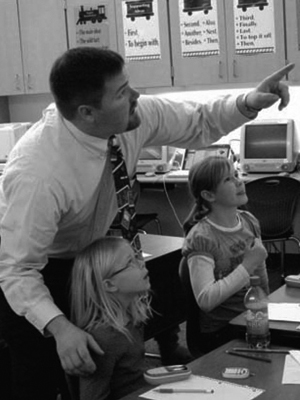
Wyoming Elementary Principal Justin Pierantoni knows firsthand the benefits of a culture of caring in his school. He encourages staff to help instill resiliency in students who might struggle to succeed in less supportive environments.
Wyoming Elementary Principal Justin Pierantoni knows firsthand the benefits of a culture of caring in his school. He encourages staff to help instill resiliency in students who might struggle to succeed in less supportive environments.
Justin Pierantoni knows that some resilient children aren’t born that way—they can be made. So this principal of Etna Elementary School in Lincoln County School District #2 reaches above and beyond to instill resiliency in his students. The mission statement on his school’s website says it all: “Where We Think, Learn, Achieve, & Care.”
And it’s the “care” part that may make the most difference in the 265 young lives he helps shape.
“The presence of at least one caring person in a child’s life can provide support for healthy development and learning,” says Bonnie L. Benard, MSW, a pioneering researcher and practitioner in resiliency theory and application. “This is someone who conveys an attitude of compassion, who understands that no matter how awful a child’s behavior, the child is doing the best he or she can, given his or her experience.”
Benard’s resiliency work has been credited as one of three forces supporting a shift from deficit- based prevention to asset-based youth development during the 1990s.
By putting aspects of Benard’s theory of resiliency into practice, Pierantoni and his staff focus on developing competent, confident and caring students.
“Our biggest ally is communication—to help kids through anything that can happen, so they have someone to talk to,” Pierantoni says.
He adds that Etna Elementary , despite its small size, reaps the rewards of a full-time school psychologist/counselor on staff, a benefit that each school in the district enjoys.“It is not what we do that counts, but how we do it,” notes Benard, stressing the means of support is not what counts, but how it is applied to the child.
Pierantoni couldn’ t agree more. That’s why he encourages his staff to offer students ample opportunities for emotional growth, and fostering internal assets that Benard stresses as key to resilience, including: 1) social competence, 2) problem solving, 3) autonomy, and 4) sense of purpose.
“Using a language of strengths versus a language of limitations helps adults begin to look for and find strengths in their young people—and then to name and reflect back to youth the strengths they have witnessed,” adds Benard.

